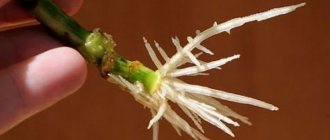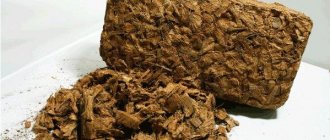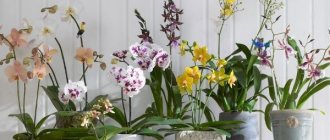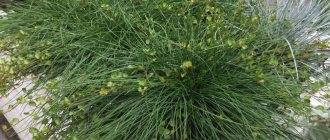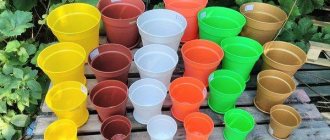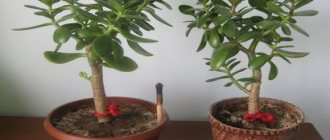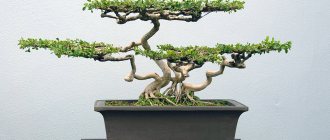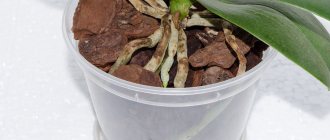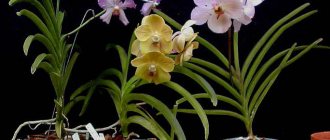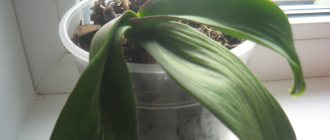The importance of choosing the right pot
The root system of phalaenopsis needs oxygen more than others : they actively participate in the process of photosynthesis and cannot cope with excessive moisture. Plus, ideal aeration of both the roots and the substrate in the container is vital for them.
The reason is in the structure of the roots: the roots are covered on top with velamen - a hygroscopic tissue filled with air. If the air in the root area does not circulate, the velamen begins to rot, and without this shell, the orchid will not be able to absorb the necessary microelements.
This is why transparent plastic pots are chosen for transportation and sale.
Possible problems and difficulties
Growing orchids in water and regular soil is not always successful. In rare cases, problems may arise:
- The edges begin to wrinkle. The reason is high air temperature. During the day and night, the difference in changing temperature should not exceed 8C.
- Dryness and rotting of the root system. The reason is excessive watering, a pot that is too narrow, squeezing the roots, heavy watering after a long absence of water.
- No flowering. Treatment is heat stress. The difference between the temperature at night and during the day should be 12-14C.
Constantly keeping orchids in water is accompanied by the formation of a disease, the cause of which is pathogenic microorganisms, for example:
- fungi;
- bacteria.
Note!
To prevent problems, you need to properly care for your beauties. The ideal microclimate for fungus is a damp and secluded place, for example, a glass flowerpot in which there is no ventilation.
Preventive measures include periodic ventilation of the container. Epiphytes absolutely need air, as it can prevent:
- moisture stagnation;
- mold formation with bacteria.
Phalaenopsis in water needs:
- sufficient lighting;
- maintaining the desired temperature;
- proper watering.
What should the “correct” container provide?
The “correct” pot should:
- allow excess moisture to escape without delay;
- allow air to circulate inside, providing the roots with the proper amount of oxygen;
- allow the root system to grow without problems, without oppressing it;
- provide the necessary temperature conditions (not allowing the root system to overheat or overcool) and access of light to the roots;
- allow you to safely remove the plant from the container without damaging the root system.
Description of the flower
The Vanda orchid has a strong root system . The length of the root can reach 2 meters. The roots are thickened, grayish-green in color and covered with a thick layer of velamen. The stem of this flower at home stretches up to 1 meter in length, and in nature up to 3 meters.
The leaves of the flower are large and arranged not closely and in two rows. They are leathery and fleshy and bright green. The flowers of the plant can have the following colors:
- snow-white;
- cream;
- lemon yellow;
- orange;
- cherry red;
- light pink;
- deep raspberry;
- violet;
- violet-blue.
How to choose?
The number of pots on store shelves is amazing, and people who have been growing orchids for a while now find it difficult to make the right choice.
Consider the following nuances:
- The pot must have several drainage holes (at least 4) or the ability to make them yourself (not only at the bottom, but also on the sides).
- The diameter of the container should be 3-4 cm greater than the size of the root system. Height is approximately equal to width.
- The most acceptable material is soft plastic, transparent or light colors.
Landing
Disinfect the glass container (douse it with boiling water) or sterilize it (like jars).- Pour a thick layer of expanded clay onto the bottom of the container (you can use other drainage). Disinfect it in advance.
- Lay a layer of sphagnum moss (you can do without this step).
- We fill the rest of the space with substrate (purchased or prepared independently).
- Pour the contents of the container with warm, settled water for 30 minutes to saturate.
- Drain the water completely and plant a flower in the bark. The moss is moistened in water, squeezed out and distributed in a thin layer on the surface of the bark, leaving free space around the root collar.
Watch a video about planting an orchid in a glass pot:
In what containers should you not plant a flower?
There are pots in which it is strictly not recommended to plant orchids:
- Made from unfired ceramics (the roots of the plant grow to the inside and are injured during transplantation).
- Pots are oblong (in such containers the flowers do not receive full air and moisture).
- The containers are too wide and deep for growth. Phalaenopsis grows very slowly, and excess soil will only hinder it.
You cannot grow phalaenopsis in the same pot with any other plant: the orchid will not bloom.
Contents in flasks
The difference lies not only in their beautiful blooms, but also in their breeding methods. While many flowers grow on the ground, orchids grow from tree bark, clinging to it. They obtain useful components and moisture with the help of aerial roots. Moisture comes from the air or fog, and useful components from their residues that accumulate in the tree bark. But this process occurs in the humid tropics, where the habitat for orchids is very suitable. It is impossible to create such an atmosphere in indoor conditions. There is more than one method for growing an orchid:
- growing in water - hydroponics;
- orchid without substrate and liquid;
- breeding in soil.
If the roots of the plant are constantly in liquid, they will begin to rot. Therefore, they should not be completely submerged, but rather be above the liquid. It is not necessary to switch to keeping it in a flask right away, especially for the flower itself:
- First you need to pull it out of the ground, clean the roots, put it in water for a couple of days, and then dry it the next day. You do not need to drain the liquid completely, but so that one centimeter of the roots are still immersed in it.
- After a week, the orchid can be left in the water for several days, but one day should be allowed to dry.
- Afterwards, leave the phalaenopsis in the water for the entire time, changing it and observing the condition of the roots. If they change color to silver, it means the flower needs to be watered.
At this time, the growth of new aerial roots will be noticeable, and green shoots will begin to appear on the old ones.
Please note! With this method, growing may be difficult due to rot on the roots. To cope with it, you need to take the flower out of the water for a day and treat the roots with a fungicide. If algae appears on them, then you should not get rid of them, as this helps air exchange
A small part of the roots dies off if the habitat has changed to aquatic, and instead of them appear those that are adapted for the plant to stay in water
If algae appears on them, then you should not get rid of them, as this helps air exchange. A small part of the roots dies off if the habitat has changed to aquatic, and instead of them, those adapted for the plant to stay in water appear.
To prevent the appearance of fungus, you need to use semi-hydroculture - an unusual substrate that does not provide the flower with any nutritional components, but keeps it in a standing position. The flower receives all its nutrition through fertilizers, which are diluted in water. They are easily digestible, and therefore do not waste a lot of energy, directing it to development.
Advantages and disadvantages of different types of pots and their photos
Clay
Clay flowerpots are used less often than plastic ones. Advantages:
- Since clay is an environmentally friendly and porous material, it allows the soil to “breathe”.
- The material retains liquid, releasing it gradually to the soil.
- The clay container is very stable and will not tip over under the weight of the flower.
- It looks aesthetically pleasing and fits into almost any interior.
Disadvantages of clay:
- If you plant a flower in a pot made of untreated clay, the roots of the orchid will begin to grow to it.
- Clay heats up quickly when standing in the sun or near a heater. Naturally, moisture evaporates faster.
Buy a smooth, poured ceramic vessel, slightly larger than the root system and, preferably, a light color.
Once you buy a clay pot, do not plant the orchid in it on the same day. Place the container in a bowl of water for several hours: the clay will be saturated with moisture and will accumulate less salt in the future.
Glass
Since glass pots do not have drainage holes, the plant's roots will quickly begin to rot. You can buy glass containers only if the room where the orchid grows has very low humidity (which happens quite rarely). In this case, the drainage layer should occupy half the container, and the glass should be transparent, without dark patterns.
And, of course, a glass pot can be used not as the main flowerpot, but as a flowerpot for beauty .
Capacity requirements
To grow flowers, you need to choose glass pots for orchids. This procedure is important, since an incorrectly selected pot will negatively affect the growth and development of the pet. Caring for phalaenopsis at home is no different from placing it in regular soil, but you need to take into account important nuances.
- Type of flowerpot.
- The material from which it is made.
- Form.
- Location in the house.
The form can be of various types:
- Classic, elongated upward - looks beautiful.
- Cylindrical, resembling a glass with a flat bottom.
The last type is not the most ideal choice, because:
- it is large in size;
- The containers do not look very attractive;
- it is not practical due to its inappropriate decorativeness.
It is better to choose a glass vase in the shape of a cognac glass, which:
- large;
- spherical;
- flattened in height;
- can accommodate the entire root system so that it does not stick out;
- compact;
- decorative.
In such flowerpots, the flowers do not feel stuffy, and the roots are provided with an ideal humid microclimate.
Orchids in glass containers grow well, since the material transmits light well, but the main advantage is considered to be decorative. Maintenance requires maintenance, which is complicated by the lack of drainage in the bottom of the flask. This can lead to an excess of moisture, and this has a detrimental effect on the condition of the root system, which can lead to the death of the flower.
Important!
If the container is chosen incorrectly, the grower will be faced with the formation of a large amount of algae on the walls of the vessel. Accordingly, if you want to grow orchids without soil, then you need to strictly follow the rules for forming drainage.
You can place a pot with a plant planted in soil in a glass container, adding decorative stones to the space inside the vessel.
Advantages:
- Attractive view.
- Large selection of decorative elements.
- The roots of the plant will receive a sufficient amount of nutrients and air.
- If necessary, you can remove the outer glass container.
Minuses:
- It is difficult to choose the shape of the outer pot.
- Air circulation may be disrupted, which will negatively affect its growth and development of stems.
- There may be excess moisture.
How to do it yourself?
Advantages and disadvantages
Do you want to make a pot with your own hands? Nothing is impossible! But keep in mind that you will have to try.
Of course, there are advantages to this. You can make a container of the size that suits you: for example, if the roots of your orchid are damaged, you will need a very small pot . And these are not always on sale. However, you will have to spend time on work and, quite possibly, your first craft will not be very attractive in appearance.
How to care for an orchid in a flask?
Keeping an orchid in a vase has its advantages and disadvantages. A humid microclimate is formed and maintained behind the glass of the flask, which in turn is very useful for the root system of the epiphyte, since in nature they grow precisely in such conditions.
A significant drawback is the rapid cooling of the glass, which can cool the roots. And cold and moisture, as you know, are very harmful to orchid roots and can provoke the appearance of mold and rot.
In addition to the low thermal conductivity of glass, there is its fragility and high rate of contamination - with limescale, colonies of algae and fungi.
Advice! The disadvantages of glass are offset by another material – plastic. Even a plastic bottle with the top cut off may work.
You need to know about all these features of materials and shapes before placing the plant in such a container. If this does not stop the grower and a similar experiment is planned, it is also necessary to know about proper care in specific conditions.
Watering
The watering procedure is no different from what a gardener would do with a plant in a pot and flowerpot. It is necessary to carefully pour water into the flask so that all the roots are immersed. After 30-45 minutes, the water must also be carefully drained. Use rain, melt or filtered water with a minimum amount of dissolved mineral salts.
Watering is done in the usual way.
Attention! Be careful when draining water. The flask can become very slippery, you can drop it and accidentally injure yourself or others with shards of broken glass. After draining the water, you need to make sure that it does not remain in the vase
Watering is carried out as needed, depending on the condition and requirements of the plant. On average, this is 2-3 times a week in warm weather and 1 time in cloudy weather. On especially hot days, the frequency of watering can be daily. Watering is carried out in the morning so that the plant has time to dry out by night.
After draining the water, you need to make sure that it does not remain in the vase. Watering is carried out as needed, depending on the condition and requirements of the plant. On average, this is 2-3 times a week in warm weather and 1 time in cloudy weather. On especially hot days, the frequency of watering can be daily. Watering is carried out in the morning so that the plant has time to dry out by night.
Ventilation
For epiphytes, the presence of fresh air is extremely important. It is necessary to ventilate the plant periodically
The size of the container should be sufficient so that the orchid roots fit freely inside, can be ventilated, and air can easily get inside.
Disinfection of the flask
Over time, the glass of the container becomes covered from the inside with a layer of algae, fungi or a coating of salts. For this reason, the flask must be constantly washed and kept clean.
Disinfection can be carried out with a weak solution of potassium permanganate. During the procedure, remove the plant from the container.
Sometimes the orchid's roots get stuck to the sides of the vase, so be careful when removing it.
Feeding
Epiphytic orchids in nature feed on humic substances that collect in the cavities of tree bark or between stones. In cultivation, these plants, like no other, need proper feeding.
During the period of active growing season and growth of green mass, feed the orchid with liquid fertilizers at ¼ of the concentration indicated on the package. Before the procedure, it is necessary to moisten the roots of the plant with clean water - this measure is necessary in order to exclude the possibility of burning the delicate root system with the fertilizer solution. Such fertilizing can be alternated with foliar fertilizing “by leaf”.
Important! Feeding during the dormant period is sharply reduced or not carried out at all, depending on the type of particular orchid.
Disease Prevention
The best prevention is to keep the plant in proper conditions and maintain its hygiene. Care must be taken to ensure that the orchid receives a sufficient amount of light, especially in winter, when the length of daylight hours is sharply reduced. Hypothermia of the root system, dirt and debris inside the flask are also unacceptable. Remove dead roots and leaves of the plant in a timely manner.
Fungicide treatment
It is carried out for preventive purposes with systemic fungicides according to the instructions.
Due to improper watering, orchids may rot roots or leaves.
If the plant is nevertheless affected by bacteria or fungi, treatments are carried out in medicinal dosages.
Is it worth making the container yourself or is it better to buy it?
If you are not sure that you can handle the job, or you simply don’t have time, buy a potty in the store.
Preparation of materials and tools
There are several options for making a pot. You may need the following items:
- Coconut shell.
- Pine planks.
- Drill.
- Thick fishing line or copper wire.
- Plastic bucket.
Manufacturing
- Scoop out the meat from a large coconut, wash it and dry it. Using a drill, drill several holes on the sides and bottom. This pot allows you to create ideal tropical conditions for mini orchids.
- Take any plastic bucket (like an ice cream bucket) and make holes in it. Instead of a drill, you can use a hot nail. Decorate your creation with bright fabric, wire or other materials to your liking.
- The pine basket is made from pine planks of suitable size. They are polished and fastened together with wire or a special adhesive.
- A hanging basket made of bamboo or wood is also suitable for growing orchids. But don't forget to put a champagne cork at the bottom. Thanks to this, the roots will not be pressed into the bottom of the container.
Transplanting into hydroponics
An orchid without soil can be actively growing in a vessel with hydroponics, a solution that has the necessary nutrients added in precise proportions. This placement allows you to go on vacation for a short time and not worry that the roots will dry out and your pet will die from a lack of moisture and water.
Advantages of the method:
- Lack or excess of fertilizers is excluded.
- The formation of pests, rot and similar problems is absolutely impossible.
- Such orchids in a vase do not need to be replanted.
You may be interested in: How to care for orchids in a pot after purchase Why the leaves of an orchid wither and how to save it Features of the care and propagation of the Dendrobium Nobile orchid
Growing an orchid in water is quite simple, but many people prefer to plant it in a substrate consisting of the following components:
- Expanded clay designed specifically for plants and its size should be 8-14 mm. Before use, rinse the material thoroughly and rinse with running water.
- Perlite fraction 3-6 mm, which has capillary properties.
- Large, medium and fine diatomaceous earth that can absorb 150% of liquid, which is more than its own weight. Before use, soak it in water for 1 hour.
- Greenmix. Composition: mineral moisture-absorbing and water-repellent wool in combination with perlite.
To grow and care for an orchid at home, you should purchase a plant from a specialized store, where they can offer healthy and uninfected sprouts. Some people prefer to order online. But, you need to be sure that the supplier is trusted and sells flowers that meet the stated technical characteristics.
An orchid in a glass vase without soil is an unusual method, but it can be used to make a collection of plants more original. Those who already use such containers confirm the fact that they are more elegant and can be used as the central part of the entire composition. They are capable of attracting glances and arousing rave reviews, especially if Wanda blooms luxuriantly. Accordingly, before growing an orchid, you need to weigh the pros and cons.
What if the plant was transplanted into the wrong container?
If you chose the wrong container, your orchid will quickly let you know. A “swamp” in the substrate, the germination of greenery or algae is a signal that the flower needs to be replanted urgently. Otherwise, its root system will soon rot. Replanting will also be required if the capacity for the plant is clearly large.
If you notice that a blooming orchid has begun to fall on its side, tie it up and place the pot in a glass flowerpot. Replant later when flowering ends.
If you want your green pet to look fresh, bloom brightly and rarely get sick, take care in advance of the container for planting it. In the article we have listed all the important nuances of choice. It's up to you!
Features of care
An orchid in glass needs thorough care. Watering should be carried out under the same conditions as when kept in a regular pot:
- Fill the orchid pot with water until the roots are completely hidden. They must be thoroughly soaked.
- Use soft, settled water, and it should contain a minimum of salts. The root system of this plant is very delicate and can be easily damaged. With improper care, plaque may form that is noticeable to the naked eye and significantly spoils the appearance.
It is necessary to water with melt or rain water, but only if the collection is carried out in a region with a clean atmosphere and normal environmental conditions. Similarly, cultivation in water should be carried out using clean, settled liquid without harmful impurities.
Note!
After watering, leave the vase with orchids for half an hour, then drain the water. It is important to be careful not to drop the container, as wet glass has a slippery surface.
You need to make sure that there is not even the slightest amount of water left in the container. Orchids should be kept in water 2-3 times a week, provided that the weather is warm, and once in cool and cloudy weather.
The florist must carefully monitor the condition of the plant to take into account its needs, change the microclimate, watering, air temperature around the flower, etc. For example, an orchid in a glass vase needs regular feeding, which happens naturally in nature, since humus substances are washed off from the tree bark by rain, which is extremely beneficial for the root system.
At home, a selection of microelements, their dosage and timely application are required. Fertilize after flowering, for which use a not too concentrated solution, which can be added more often than a strong concentrate.
During the period when active vegetation occurs and green mass increases, you need to introduce liquid fertilizer 1-2 times a week. Before the procedure, wet the roots of the flower in water to prevent them from being burned by the solution. Feeding on leaves, which alternate with root feeding, is considered especially effective, and pest control should be done using a fine sprayer capable of creating a misty stream.
To make the plant feel comfortable, you need to periodically remove it from the container for a short period of time. This way, the orchid in a glass flask will actively grow and develop, and air baths can be done while bathing or if there is a need to wash the flowerpot from dirt.
The most important thing is not to pull the flower out of the container, as the roots can stick to its walls, and therefore care is important to prevent damage to them.
Features of the development and growth of plants without soil
Vanda is a monopodial epiphyte , less often a lithophyte, and it feels great with bare roots without soil . Usually it has a powerful system of aerial, velamen-covered, gray-green roots. In nature, it clings to them, holding onto a support.
It should be understood that vandas are tropical plants and they live in a very humid climate, extracting moisture and nutrition from all parts of their body from precipitation and air.
In indoor conditions, the plant should recreate similar conditions. And if the flask takes care of the humid microclimate necessary for the aerial roots, then the gardener will have to feed the vanda a little more often than other orchids.
Substrate and nutrient liquid for orchids
In the absence of soil, the root system of the flower still needs to anchor itself in something, so good drainage is necessary. Expanded clay, glass beads, polystyrene foam, perlite, diatomaceous earth, green mix are suitable, that is, those materials that do not rot in water.
Expanded clay is ideal as a substrate, the so-called semi-hydroculture, - a porous material that can absorb and release moisture. Place a layer of expanded clay on the bottom of the orchid pot so that it covers the holes. Plant the orchid vertically, arrange the roots roundly so that they lie naturally, without creases or tangles.
Next, pour a thin layer of perlite, approximately 5-6 mm. Then - diatomite, first soaked in water for an hour. There is a layer of green mix on top. The ratios of the components are approximately equal. It is allowed to use one type of substrate; most gardeners choose expanded clay.
A glass orchid pot filled with substrate with a flower installed in it is filled with water. It should not touch the top of the rosette, but should be about 1 cm below it. You should take only filtered or settled water, and preferably rain or, if possible, melt water. These fastidious plants can only be fed with special nutritional mixtures specifically for orchids, based on the life cycle of the flowers. Mix food with prepared water.
How to transfer an orchid from soil to water
If you decide that the orchids will be better off in water, the transfer to a “new place of residence” must be done gradually, otherwise the plant will experience stress and may die from a sudden change in “climate”. Step by step guide:
Vanda orchid in glass. Vanda - an orchid of extraordinary beauty
The genus Vanda belongs to the orchid family and includes about 60 species. Among them there are lithophytic species, but for the most part they are epiphytic plants, which determines the specific appearance of the root system - vandas, despite their rather large size, grow clinging to tree trunks. The straight stem of this monopodial (with one growth point) flower can reach a height of one meter.
Many of its aerial roots are covered with a layer of velamen. These are dead cells that form porous, hygroscopic tissue and absorb moisture from the air.
Holding it with their spongy structure, they protect exposed roots from sunburn and create a water supply, helping the plant survive dry periods without loss. Depending on the climate in which a particular vanda grows, its leaves will be of different colors and degrees of density, more fleshy - in species well adapted to low humidity. Their shape also varies: belt-shaped, valval (cylindrical) and ovoid. Vanda differs from other types of orchids in having flower petals located in the same plane and the absence of pseudobulbs.
Peduncles are found both drooping and erect. The inflorescence is a raceme with several fairly large flowers 9–10 cm in diameter. There are fragrant species. The color of the petals can be very different: from blue-blue to red-orange.
You can often see a so-called network of darker veins. Under favorable conditions, flowering occurs several times a year and lasts up to three months.
Tips and secrets of professionals
What to do if the root system is very weak?
You can help the plant grow a lush root system by using root or its analogues according to the instructions.
Ventilation, airing the plant
Although Vanda comes from the tropics, she prefers the air to be fresh. Therefore, it is necessary to periodically ventilate the plant.
It must be placed in the flask so that air can circulate freely and get inside.
The size of the container in which the vanda is contained must be sufficient for the roots to fit freely inside.
Disinfection of containers
Unfortunately, over time, the inside of a glass vase becomes covered with a layer of algae or a coating of salts. Therefore, the flask will have to be washed constantly . You can disinfect it with a weak solution of potassium permanganate. The plant, of course, should be removed from the vase during this procedure.
Suitable pot for orchid
The selection of a suitable container for growing an orchid is related to its natural characteristics. For orchids, a suitable container is determined by the following criteria:
- The ability of the pot to ensure the outflow of moisture from the roots.
- Sufficient air supply to the root system.
- Smooth pot material that does not interfere with the safe removal of the plant.
Note! You should avoid using ceramic pots to grow orchids. The shoots of the plant cling to the rough surface of the vessel, making it difficult to remove them from it without damaging it when replanting.
- The material should not contribute to overheating or hypothermia of the rhizome, maintaining an optimal temperature.
Materials that meet the listed parameters are plastic and glass . An orchid placed in a plastic pot is less demanding to care for. Condensation does not accumulate on plastic walls (in the presence of filtration holes), and algae does not form on the roots and walls of the vessel. Finding a plastic pot that meets all the requirements is easier than finding a suitable glass container. Flowerpots made of glass look more impressive and aesthetically pleasing.
Both glass and plastic containers can be transparent. The question arises: is it necessary to keep an orchid in a container that allows light to pass through?
Answer: transparency is not always a condition in the absence of which the orchid dies, but it significantly simplifies care. This is mainly due to the fact that transparent pots help prevent watering mistakes.
